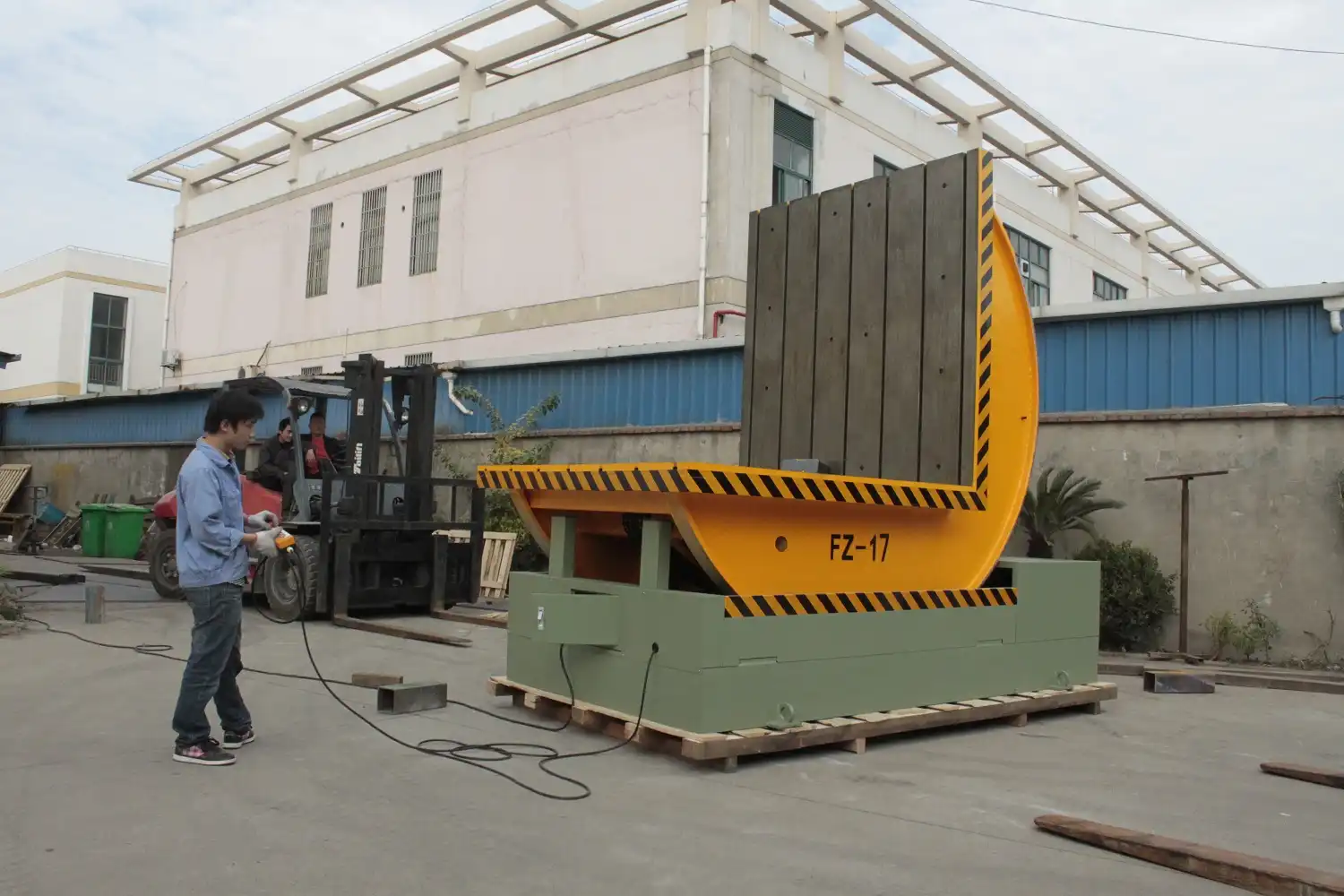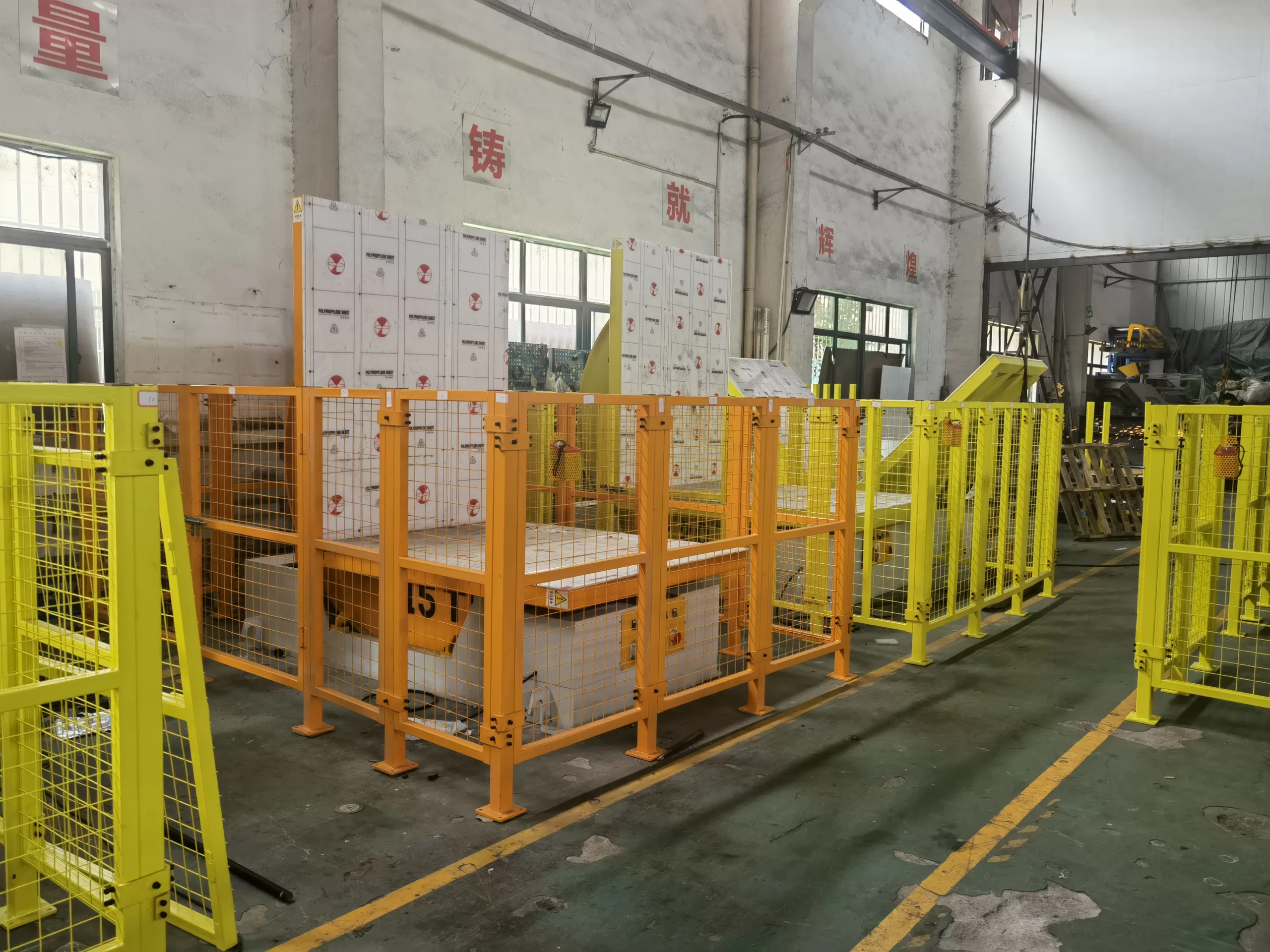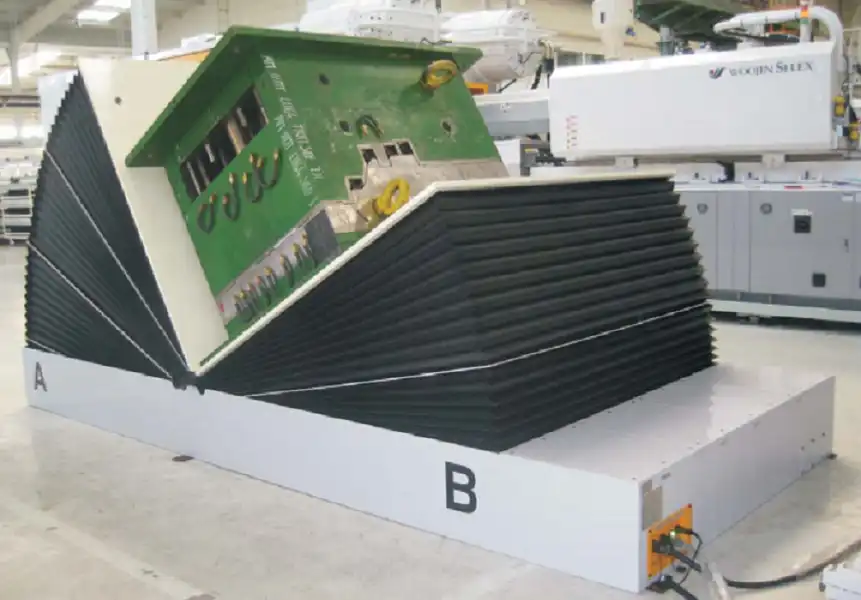What Features Should Colombian Engineers Prioritize in a Mold Flipping Machine?
When you're running a heavy industrial operation, every piece of equipment is a critical link in the chain. A single failure can bring production to a halt, costing you thousands of dollars per hour. I've seen it happen. You might have a multi-million dollar mold, essential for your entire process, but flipping it for maintenance or changeovers is a slow, dangerous, and manual task. This is a huge bottleneck. Worse, a clumsy flip can damage the mold or, even more seriously, injure an operator. The pressure to choose the right machine to solve this problem is immense, because the wrong choice doesn't just waste money—it introduces a new point of failure into your plant.
For engineers in Colombia's demanding manufacturing and steel sectors, the key features to prioritize in a mold flipping machine are robust, multi-layered safety systems, a certified load capacity with a significant safety margin, precision control through technologies like Variable Frequency Drives (VFDs), and a design that prioritizes both structural integrity and ease of maintenance. These elements work together to ensure the machine is not just a piece of equipment, but a reliable, long-term asset that enhances safety, protects valuable molds, and maximizes operational uptime.

Choosing a machine like this isn't just about reading a spec sheet. It's about understanding how each feature translates into real-world performance, safety, and cost savings for your specific environment. In my journey from an engineer on the factory floor to owning my own packing machine factory, I've learned that the details make all the difference. Let's dig deeper into the specific questions you should be asking to make sure you're making a smart investment that will pay off for years to come.
How Can Safety Features Reduce Operational Risks and Insurance Costs?
You know the feeling in the pit of your stomach when a safety alarm goes off. Production stops. Everyone's first thought is, "Is anyone hurt?" The direct and indirect costs of a workplace accident are staggering, from medical bills and worker compensation to lost production and potential legal issues. It's a nightmare scenario for any manager or owner. Some might see advanced safety features as an added expense on a machine, but I see them as the cheapest insurance you can buy. They are a direct investment in the stability and predictability of your entire operation.
The most critical safety features on a mold flipper are designed to prevent accidents before they happen. Prioritizing things like interlocking limit switches, prominent emergency stops, audible and visual alarms during operation, and mechanical or electrical overload protection directly cuts down your operational risk. This proactive approach not only creates a safer workplace for your team but also has a tangible financial benefit, often leading to reduced insurance premiums and, most importantly, preventing catastrophic downtime.

Beyond the Basics: What True Safety Integration Looks Like
A simple E-stop button isn't enough. In a modern industrial environment, especially in a country like Colombia where safety standards are rightly becoming more stringent, you need a system of interconnected safety features. Think of it as layers of protection.
- Limit Switches and Interlocks: These are non-negotiable. A limit switch ensures the machine stops at the precise 90-degree or 180-degree point, preventing over-rotation that could stress the structure or the mold. Interlocks should be present on any access panels or safety gates, automatically stopping the machine if a guard is opened during a cycle. This prevents an operator from accidentally reaching into a moving machine.
- Failsafe Braking: What happens if the power goes out mid-flip? A cheap machine might let go. A quality machine has a failsafe electromagnetic brake on the motor. The moment power is cut, the brake engages, holding the load securely in place. I once visited a plant where a power surge caused a flipper to jolt, and only its failsafe brake prevented a half-million-dollar mold from crashing to the floor.
- Overload Protection: This is your machine's self-preservation system. It should have both electrical overload protection (monitoring the motor's current) and a robust mechanical design that can withstand unexpected shocks. The system should alert the operator and halt the operation if the load exceeds the machine's rated capacity, preventing catastrophic failure of the motor, gearbox, or frame.
The Tangible ROI of Investing in Safety
It can be hard to convince the finance department to spend more on a "safer" machine. So, let's talk their language. The return on investment (ROI) for safety is found in the costs you avoid.
| Feature/Metric | Basic Machine | Machine with Advanced Safety | Financial Impact |
|---|---|---|---|
| Initial Cost | Lower | 10-15% Higher | Initial investment required. |
| Operator Training | Minimal | Comprehensive | Higher initial time cost, but reduces human error. |
| Risk of Accident | Moderate to High | Very Low | Avoids costs of injury, downtime, legal fees. |
| Insurance Premiums | Standard Rate | Potential for Reduction | Insurers often reward proactive risk management. |
| Downtime from Incidents | Higher Probability | Lower Probability | Prevents massive losses from production halts. |
A client of mine in the steel industry was initially hesitant to invest in a flipper with a full safety suite. Six months after installation, a crane operator accidentally tried to lift a mold before it was fully clear of the flipper. The machine's interlock sensors detected the improper positioning and prevented the cycle from starting, averting a collision that would have destroyed the mold and the flipper. That single non-event paid for the safety features many times over.
What Role Does Load Capacity and Structural Integrity Play in Long-Term Reliability?
You have an 18-ton mold, so you look for a 20-ton capacity machine. It seems logical, right? But this is one of the most common and costly mistakes I see engineers make. A machine's nameplate capacity is only the beginning of the story. The real world of a steel mill or a busy factory floor is not a perfect laboratory. You have dynamic forces, vibrations, and the simple wear and tear of thousands of cycles over a decade. A machine that is only "strong enough" on day one is destined to become a maintenance problem and a point of failure down the road.
The true reliability of a mold flipping machine comes from its structural integrity and a realistic, well-engineered load capacity. For engineers in Colombia, this means you must look beyond the number and investigate the quality of the steel, the certification of the welds, and the built-in safety factor. A machine built with a safety factor of at least 125% and constructed from high-tensile steel like Q345B is an investment in long-term, uninterrupted production. It's the difference between a machine that lasts five years and one that lasts fifteen.

Deconstructing the Machine's Skeleton
The long-term performance is determined by the quality of its core components—the parts you can't easily see. When I evaluate a machine, I look at its bones.
- Steel Grade: Many low-cost machines use standard Q235 steel. It's fine for light-duty applications. But for a mold flipper that will handle heavy, expensive assets day in and day out, you should insist on Q345B or an equivalent high-strength, low-alloy steel. It has better fatigue resistance and can handle the stresses of repeated heavy use without degrading.
- Welding Quality: A strong frame is useless if the welds are weak. Ask the manufacturer about their welding procedures. Are their welders certified? Do they perform non-destructive testing (NDT) like ultrasonic or magnetic particle inspection on critical welds? A single bad weld can be a catastrophic failure point.
- The Drivetrain: The motor and gearbox are the heart and muscle of the flipper. Look for reputable brands (like SEW, Siemens, or a top-tier domestic equivalent). An undersized or low-quality gearbox will be the first thing to fail, leading to costly repairs and extended downtime. The drivetrain should be engineered specifically for the high-torque, low-speed application of turning a heavy, off-balance load.
Capacity on Paper vs. Capacity in Reality
The number printed on the machine is its static load capacity. But a mold doesn't just sit there; it accelerates and decelerates. This creates dynamic loads that can exceed the static weight of the mold.
| Feature | "Budget" Flipper | "Industrial-Grade" Flipper | Long-Term Implication |
|---|---|---|---|
| Stated Capacity | 20 Tons | 20 Tons | Looks the same on paper. |
| Real Safety Factor | 100-110% | 125-150% | Can handle unexpected dynamic loads. |
| Frame Material | Q235 Steel | Q345B High-Strength Steel | Resists metal fatigue and stress fractures. |
| Key Components | Generic/Unknown Brand | Reputable Brand (e.g., SEW) | Higher reliability, easier to source parts. |
| Expected Lifespan | 5-7 Years | 15+ Years | Lower Total Cost of Ownership (TCO). |
I remember a case from my early days as an engineer. A factory bought a flipper based purely on the lowest price for their required tonnage. Within three years, they started noticing a slight sag in the main support beam. It was metal fatigue. The machine was technically meeting its spec, but it wasn't designed for the relentless reality of a three-shift operation. They had to replace it, effectively paying for a mold flipper twice. That's a lesson you only want to learn once.
Why is Precision Control and Automation a Non-Negotiable Feature?
Imagine trying to park a massive truck by just slamming on the gas and then hitting the brakes. The jerky, uncontrolled movement would be incredibly inefficient and dangerous. The same principle applies to flipping a multi-ton mold. A machine with a simple on/off control system will jolt the load at the start and stop of every movement. This constant shock puts immense stress on the machine's gears, bearings, and frame. More importantly, it can damage your expensive mold, cause it to shift, or create a safety hazard.
This is why precision control, typically achieved with a Variable Frequency Drive (VFD), is not a luxury—it's an absolute necessity. A VFD allows the machine to smoothly ramp up to speed and gently slow to a stop. This "soft start" and "soft stop" capability protects the equipment, the mold, and the operator. For a modern Colombian factory focused on efficiency and quality, this level of control is fundamental to a lean and reliable operation. It reduces wear and tear, minimizes the risk of damage, and makes the entire process faster and more repeatable.

The Unseen Power of the VFD
At its core, a VFD is a motor controller that adjusts the frequency and voltage of the power supplied to the motor. But what does that mean in practical terms for a mold flipper?
- Smooth Operation: The most obvious benefit is the elimination of jarring starts and stops. The rotation is fluid and controlled, which is especially important when dealing with molds that may have sensitive internal components or cores.
- Reduced Mechanical Stress: Every jolt from a direct-on-line start sends a shockwave through the entire drivetrain. It's like hitting the gearbox with a hammer on every cycle. A VFD smooths out that impact, dramatically extending the life of the gearbox, chains, bearings, and the motor itself.
- Energy Savings: A motor starting directly draws a huge inrush of current, often 6 to 8 times its normal running current. This is inefficient and puts a strain on your factory's electrical system. A VFD ramps up the power gradually, leading to lower peak energy demand and reduced electricity costs over the life of the machine.
- Variable Speed Control: A VFD allows the operator to run the machine at different speeds. You might want a slower, more careful speed for a particularly complex mold, or a faster speed for a standard, high-volume changeover. This flexibility improves both safety and productivity.
Automation for a Safer, More Productive Floor
Precision control is the foundation, and automation is the next step. In today's competitive environment, you want to reduce manual intervention wherever possible to increase speed and reduce human error.
| Control System | Direct On-Line (Manual) | VFD with Remote Control | Key Benefit |
|---|---|---|---|
| Cycle Start/Stop | Abrupt, jerky motion | Smooth, controlled acceleration | Extends machine life, protects mold. |
| Positioning Accuracy | Relies on operator skill | High, repeatable accuracy | Reduces alignment errors. |
| Operator Location | Next to the machine | Safe distance away | Dramatically improves operator safety. |
| Cycle Time | Slower, requires more care | Faster and more consistent | Increases throughput. |
A wireless remote control is a simple but powerful piece of automation. It allows the operator to stand at a safe distance, with a clear view of the entire operation, away from the crush zone. This single feature drastically improves safety. Furthermore, the flipper can be integrated with your other automated systems. For example, it can receive a signal from an overhead crane that a mold is in place, and in turn, signal to the next station when the flip is complete. This kind of machine-to-machine communication is a core principle of Industry 4.0 and is essential for achieving the high levels of productivity that modern factories require.
How Does Maintenance Accessibility and After-Sales Support Impact Total Cost of Ownership?
You've just bought a state-of-the-art mold flipper. It's strong, safe, and precise. But three months in, a sensor fails, or it's time for routine lubrication. Your maintenance team opens the panel and discovers that to reach the main grease point, they have to remove three other components. A 15-minute job turns into a 3-hour ordeal. Or worse, a unique part breaks, and you call the supplier, only to find out the lead time for a replacement is six weeks from overseas. Your brand-new machine is now a very expensive, idle piece of metal, and your production line is crippled.
This is why the machine's design for maintainability and the supplier's after-sales support are just as important as its performance specifications. The total cost of ownership (TCO) isn't just the purchase price. It's the purchase price plus the cost of running, maintaining, and repairing the machine over its entire life. For an engineer in Colombia, choosing a machine that is easy to service and a supplier who acts like a partner is critical for minimizing downtime and ensuring the equipment provides value for a decade or more.

Designing for the Person with the Wrench
A great engineer doesn't just design a machine to work; they design it to be maintained. When I review a new machine design at my factory, I always put on the hat of the maintenance technician.
- Centralized Lubrication: Are all the grease points bundled together in one or two easily accessible blocks? Or are they scattered all over the machine, some in hard-to-reach places? Centralized lubrication ensures that routine maintenance actually gets done, preventing premature wear on bearings and moving parts.
- Standard Components: Does the machine use standard, off-the-shelf bearings, sensors, motors, and pneumatic parts that you can source locally in Bogotá, Medellín, or Cali? Or does it use proprietary components that you can only buy from the original manufacturer? Relying on proprietary parts creates a huge risk of extended downtime while you wait for shipping.
- Clear Documentation and Labeling: The electrical cabinet should be a model of clarity, with every wire and component clearly labeled, matching the schematics provided. The user manual should be comprehensive, with detailed maintenance schedules, troubleshooting guides, and a complete parts list. It should be available in Spanish, not just English or Mandarin. This empowers your own team to solve problems quickly.
Choosing a Partner, Not Just a Supplier
The relationship with the manufacturer is a long-term one. Their support can be the difference between a minor issue and a major shutdown. You are not just buying a product; you are investing in their expertise and commitment.
| Supplier Evaluation Checklist | What to Look For (Green Flags) | What to Avoid (Red Flags) |
|---|---|---|
| Installation & Training | Offers on-site supervision and comprehensive training for operators and maintenance staff. | "It's easy, your team can figure it out from the manual." |
| Spare Parts | Guarantees availability of critical spares for 10+ years. Can provide a recommended spare parts list with the initial purchase. | Vague answers about parts. Reluctance to share component supplier names. |
| Technical Support | Provides a direct line to an engineer who knows the machine. Offers remote diagnostic support. | Support requests go to a general mailbox with slow response times. |
| Track Record | Can provide references of other customers in your industry or region. | No references available, or only provides references in their home country. |
| Documentation | Provides all manuals, schematics, and certifications in your local language (Spanish). | Documentation is poorly translated or incomplete. |
As a factory owner myself, I know the value of partnership. My goal with SHJLPACK is not just to sell a machine but to provide a total solution. That means being there for my clients years after the sale. When you evaluate a supplier, ask them the tough questions. Their answers will tell you everything you need to know about the support you'll receive when you truly need it.
Conclusion
Choosing the right mold flipper means prioritizing safety, robust structure, precise control, and a supportive partner. This ensures long-term value for your operation.




